Eye-Concept Art
Patrick Saine, an ophthalmic photographer at DHMC, turns photographs of retinas into art that looks back at the viewer. His work has been attracting national attention. (website)
By Anita Dennis
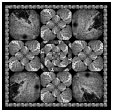 Always on the lookout for creative new patterns for his digital ophthalmic quilts, Saine came up with the idea
for Fundus Flower (top row, left, on the cover) after visiting the world's largest kaleidoscope in the Catskills.
The fundus is the curved surface opposite the pupil on the interior of the eyeball. He says he created this image
in the dead of a North Country winter, while he was daydreaming about warm climates and desert flowers.
Always on the lookout for creative new patterns for his digital ophthalmic quilts, Saine came up with the idea
for Fundus Flower (top row, left, on the cover) after visiting the world's largest kaleidoscope in the Catskills.
The fundus is the curved surface opposite the pupil on the interior of the eyeball. He says he created this image
in the dead of a North Country winter, while he was daydreaming about warm climates and desert flowers.
Patrick Saine has an eye for detail. It has been nurtured and cultivated since his youth, when his father bought him a 35-millimeter Zeiss Ikon Contaflex camera to take to Austria on a high-school exchange program. After studying biology in college, he continued to pursue what he calls avant-garde photography. But when his wife became pregnant, she decided he needed a real job.
At that point, Saine was lucky enough to marry his avocation to his education by becoming an ophthalmic photographer, capturing images of patients' retinas for a living. Since February of 1997, he's been doing so at Dartmouth-Hitchcock Medical Center.
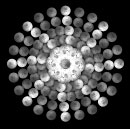
|
|
Ra Retina (top row, center, on the cover) was inspired by the Egyptian sun god, Ra. This patient, Saine notes, had a very symmetrical face. And with the aid of magnification, it is possible to see that the individual's ophthalmic blood vessels are symmetrical as well, joining up perfectly in the center of the retina. |
But his foray into digital ophthalmic "quilts," as he calls them, began quite by accident. Three years ago, he was performing a routine fluorescein angiogram: After injecting dye into the patient's arm, he shot several dozen photographs of the retinal blood vessels to record where the dye traveled. Then Saine used medical digital imaging software to create a four-square composite of key frames so that the doctors could study what might be causing the patient's eye disease. It's a procedure he'd performed hundreds of times before, but this time Saine accidentally gave the mouse an extra click and saw a 16-square grid of retinas staring back at him from the screen.
|
The pattern hovered in his mind's eye, and the next day, just for fun, Saine imported the images into Adobe Photoshop, an image-editing software program, and "stitched" them together to make a digital quilt. "It started as a lark," Saine recalls. "Then when I showed a few people and they said, 'This is totally cool,' I decided this was a vein I should explore."

|
|
Saine's inspiration for this work was a sacred Buddhist and Hindu meditation symbol, the mandala. He hoped Berry Mandala (bottom row, center, on the cover) would induce wonder and quiet in viewers— "something we don't allow enough of in our fastpaced society," he notes, adding that "the cranberry coloring came from a Midwesterner's interpretation of a Far Eastern symbol while living in New England." |
So far, Saine has created 20 of his quilts. A three-foot by five-foot photographic print of one of them, Fundus Flag (see page 42), hangs in the waiting room of the ophthalmic clinic at DHMC, where he is the manager of ophthalmic photography. His work has also taken several first and second place awards in the "Eye as Art" show at the Ophthalmic Photographers' Society annual meeting.
In addition, his quilts have been featured on the Adobe Web site ( www.adobe.com/print/gallery) since March of this year, as an example of one of the more unusual uses the company's image-editing program has been put to. And a collection of other retinal images, most of them 15 inches by 15 inches and printed on an Iris inkjet printer, were exhibited at the Contempo Gallery in St. Augustine, Fla., this spring.
"The depth of detail and color is gorgeous," Saine says of the Iris prints. "These images need to be big enough to have the richness of detail show through."

|
|
"This image is about natural order and progression," says Saine, "of color and wavelength and size and of the fluorescein dye as it ambles through the retinal blood vessels." Titled Rainbow Retina (middle row, right, on the cover), this quilt exhibits the same sort of predictability that characterizes much in nature. |
The appeal of his artwork, according to Saine, is that it works on multiple levels. "Good art has to be very simple and very complex at one time," he explains. "That's why this works: It's natural and manmade at the same time. You've got a lot of yin-yang going on."
Viewers respond to his quilts because they see a sense of natural order—"blood vessels branch like grass and flowers and trees," he says—whether or not they know it's a retina. "If they find out they may say, 'Yuck, it's an eyeball,' but then they say, 'Hey, it's a cool picture,' so it works."
Another yin-yang aspect of the quilts is that they're photographs that look at the viewer while the viewer is looking at the art. "The ultimate selfreferential act is to photograph eyes," Saine observes. "The retinal images that make up these photographs are hidden from our normal view of the world, and contrary to the rigorous documentation I perform on the job, my personal images have always been reflections of self. I've always photographed from the inside out."
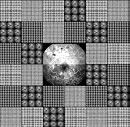
|
|
Seed Quilt (top row, right, on the cover) was the first work of digital ophthalmic art that Saine created— inspired by a serendipitous mistake. "The techniques I've used aren't advanced," he explains. "It's the originality of the idea which drives the image." |
Saine has also continued to do traditional art photography, including an ongoing series that he calls "Traveling Light." The description is a double entendre. "I firmly believe that the true subject of photography is light," he explains about one meaning. "It is light which enters the lens, passes through the shutter, and exposes the film." There's also a practical interpretation to the title. When he started the series in 1987, Saine was having a hard time carving out time to do his creative photography. With two growing children, he says, "I could no longer just disappear to photograph. So I chose to concentrate on photographing while I traveled for business, traveling light with little equipment . . . a single lens, one film, and a single camera."
|
The photographs in the "Traveling Light" series are very geometric black-and-white images that offer a new take on interiors, street scenes, landscapes, and other very familiar environments. They "document the unreal and surreal perspectives which exist around us," explains Saine. "[When] people look at this series, they turn their heads and shuffle their bodies in an attempt to find the 'right' place to look or stand."
Occasionally, Saine does assignment photography of a more journalistic nature—including for Dartmouth Medicine. He took environmental portraits to illustrate a feature about the extramedical avocations of several faculty members for the Fall 1998 issue, and his work appeared most recently in the Spring 2000 issue, with a story about a pioneering three-dimensional video-streaming presentation on the World Wide Web.
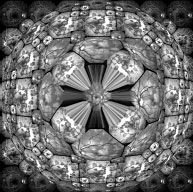
|
|
Saine used Adobe Photoshop's "Spherize" distortion filter to create the dimensionality in Retina Blues (middle row, left, on the cover), which was inspired by the work of M.C. Escher. The image curves toward the viewer, Saine points out, whereas the retina actually curves away from the viewer, like a bowl. Viewers respond to Saine's quilts because they see in them a sense of natural order—"blood vessels branch like grass and flowers and trees," he says. |
In addition, he has taught photography classes. His work has also been exhibited at the local AVA Gallery in Lebanon and in solo shows in Wisconsin and Ohio. And his photographs are in the permanent collections of the Toledo, Ohio, Museum of Art and the Wustum Museum in Racine, Wisc.
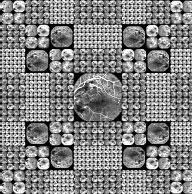
|
|
Four Squares (bottom row, left, on the cover) offers a twist on a quilting tradition that uses mirror images in a design. Here, however, Saine has created an image that at first glance looks like it contains mirror images—but that on closer inspection does not. |
But it is his digital quilts into which he puts most of his creative effort nowadays —and which are commanding the most attention in the art world.
Most of Saine's quilts start with black-and-white squares that take up about a megabyte of storage space. But by the time several are stitched together, they have been manipulated and duplicated, and color has been added in Photoshop, the finished pieces can balloon up to 350 megabytes.

|
|
Saine was inspired to create Choroidal Marble (bottom row, right, on the cover) because he lives in New Hampshire, the Granite State, which is next to Vermont, the Green Mountain State. The choroid is a membrane between the retina and the sclera, or outer surface of the eyeball. Four choroidal images were rotated and repeated to make this five-by-five grid. |
The process takes Saine up to 40 hours per quilt. (Happily for patrons of the arts, he has an understanding with his wife that he can work on his quilts as late as he wants on Wednesday nights.)
|
Saine captures about 1,000 retinal images a week, so how does he choose which ones to use in his artwork? "Some images just achieve a clarity that I notice," he says. "When you photograph the world, you're looking for situations or patterns that you can appreciate. This is the same process. I look at these images daily, and some of them jump out as special."
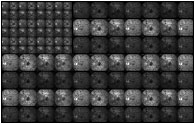
|
|
Saine intentionally simplified Fundus Flag (middle row, center, on the cover), giving it fewer stripes and "stars" than a real United States flag. He also deliberately played with three-dimensionality in this image: The red stripes appear to stand out in front of the white stripes, especially when viewed on-screen. |
After setting those special images aside, Saine draws a sketch to help him visualize the final image, then begins working with Photoshop's layers, filters, and transformation tools to stitch the pieces together. Colorizing comes last, after the image's overall structure has been established.
Saine is amazed by what people see in his quilts, and he tries to explain how he views the world and captures it in photography. "I used to say that if you have a good camera and live right, then everything will go your way," he says. "That's what happens when you get into the flow. There's so much to see in everything, it's amazing. Understanding reality truly depends on your ability to perceive."
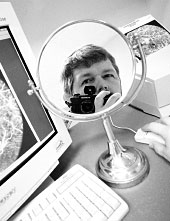
|
|
Ever the photographer, Saine shot his own visage, in his work milieu, in Self-Portrait with Mirror. |
With a bachelor's degree in biology and a master's in educational technology, plus his interest in photography, "I was a natural for ophthalmic photography," says Patrick Saine. A certified retinal angiographer since 1983, he has practiced his profession at DHMC for the past three years.
"It requires an equal measure of technical expertise and people skills," he explains. "At the same time you are juggling a fundus camera and computer technical issues, you are convincing the patient [to] sit still while you shine an uncomfortably bright light—and then a brighter flash—in their eye."
Ophthalmic photography is a relatively young field. Although photographs of the eye were taken as early as 1888, retinal photography was not in routine use clinically until the advent of fluorescein angiography in 1961. "I feel as if I can make an early mark in my chosen field," says Saine. He has indeed made a mark. He is the author of the first comprehensive book on fundus photography and fluorescein angiography; he is past president of the national Ophthalmic Photographers' Society; and he has served on the editorial board and as managing editor of the Journal of Ophthalmic Photography.
It's clearly his niche. "I can practice photography daily," he says, noting that some weeks he shoots over 1,000 images, "and still feel fresh enough creatively to follow the muse."
Anita Dennis, a freelance writer based in San Francisco, lays claim to highly symmetrical retinas. This article originally appeared on the Adobe.com Web site and is reprinted here with permission. It is copyright (c) 2000 by Adobe.com. All rights are reserved. The artwork on the cover and accompanying the article (including the self-portrait on page 41) is all copyright (c) by Patrick Saine.
Back to Dartmouth Medicine Summer 2000
